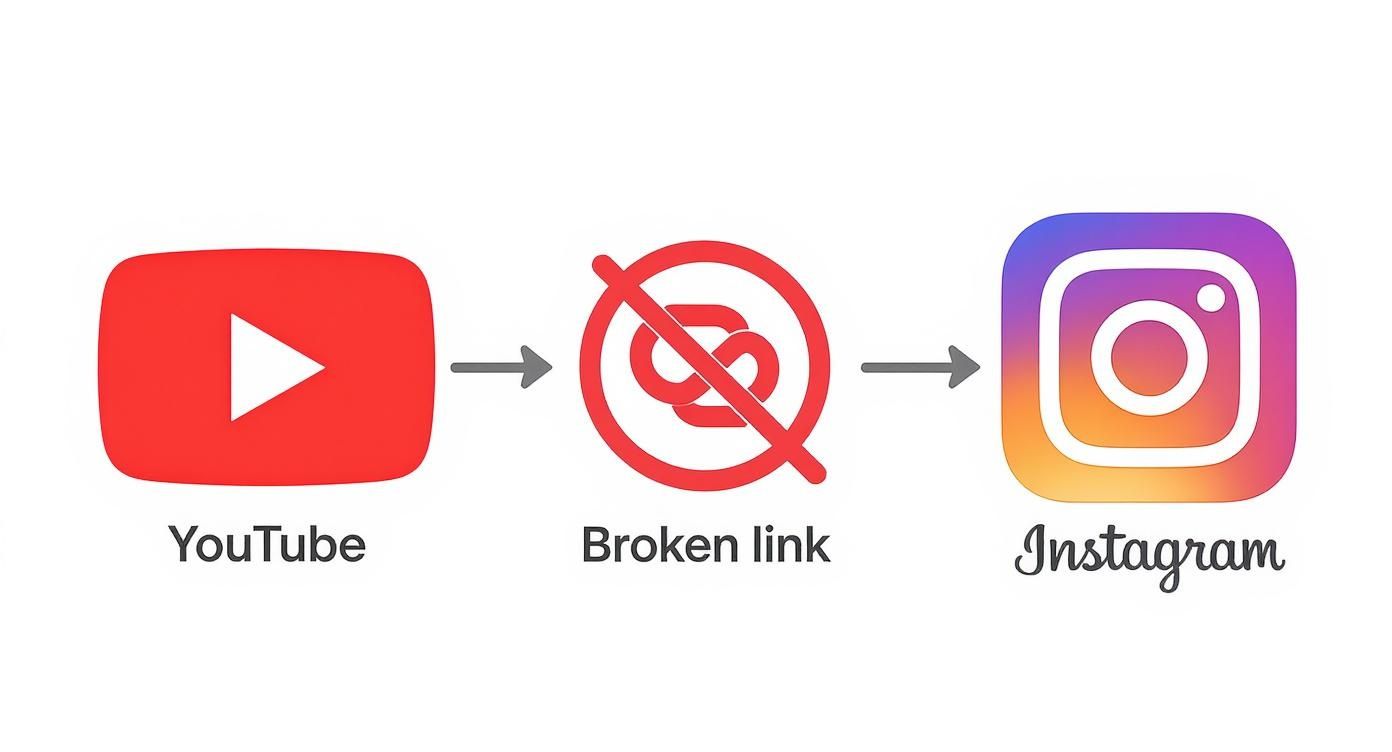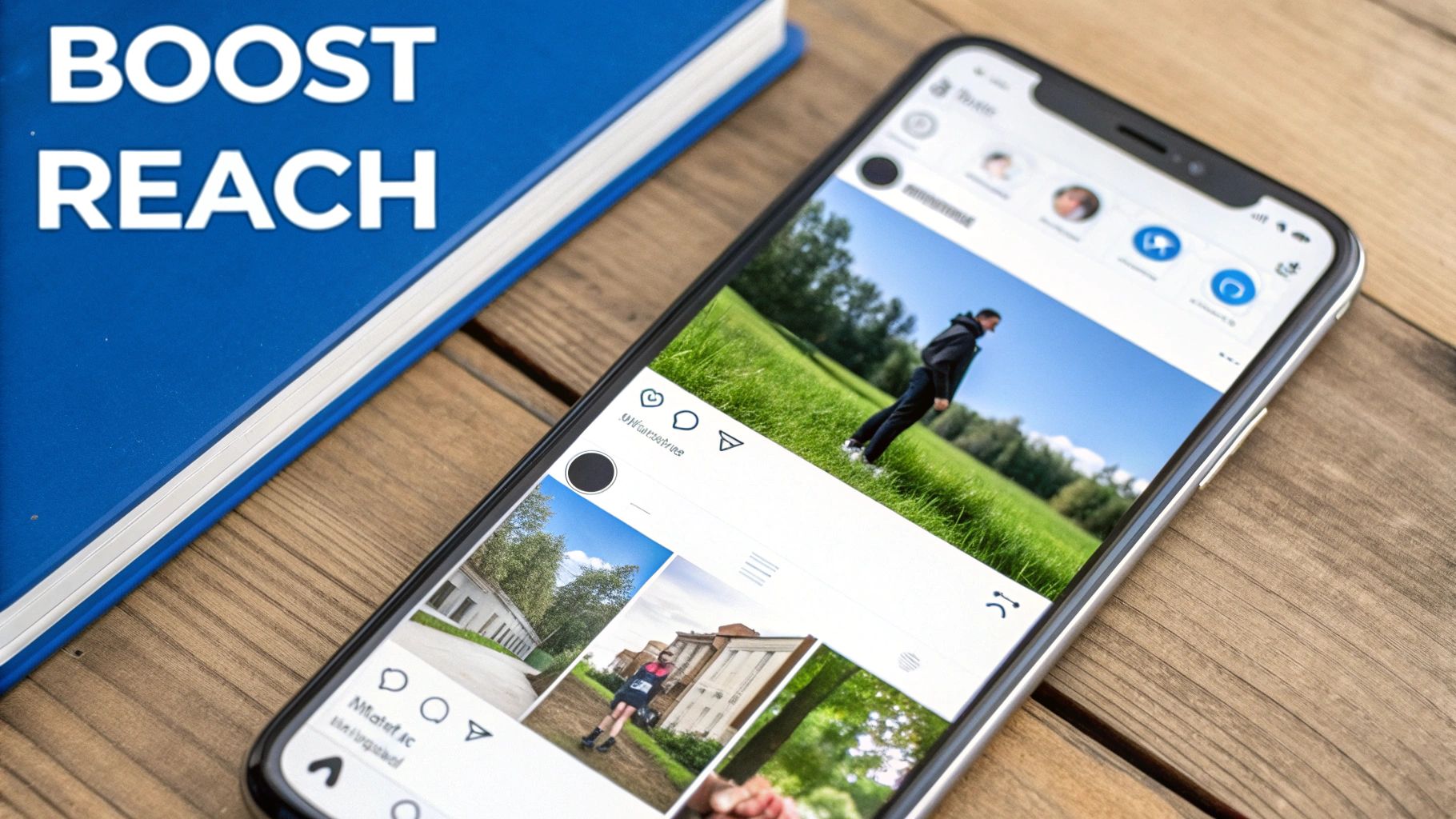The best way to share YouTube videos on Instagram is to automate the process with a tool like PostOnce. Instead of the clunky, manual process of downloading, converting, and reformatting, PostOnce automatically crossposts your YouTube videos as perfectly optimized Instagram Reels, Stories, or posts, saving you hours of work.
Your Guide to Sharing YouTube Videos on Instagram
In this guide, we'll walk through two main paths. We'll start with the fast lane—using automation for maximum efficiency. Then, we’ll cover the manual methods for those times you want complete, hands-on control over every detail.
We're going to dive deep into why simply dropping a link won't cut it. You'll see exactly how to adapt your YouTube content for Instagram's unique formats, like Reels and Stories, turning your long-form videos into powerful audience-growth magnets. The goal is to strategically bridge these two massive platforms, expanding your reach and building a stronger community around your content.
It's all about working smarter, not harder. When you repurpose your bigger videos into bite-sized clips, you create multiple touchpoints with your audience without constantly starting from scratch. This is the core idea behind effective social media cross-posting—you adapt one core piece of content to shine on each platform, maximizing every bit of your creative energy.
So, you tried pasting a YouTube link directly into a new Instagram post and... nothing happened. It's a common frustration, but there's a simple reason for it.
The two platforms are owned by rival tech giants—Google (YouTube) and Meta (Instagram). They've built their apps as walled gardens, designed to keep you inside their ecosystem for as long as possible. Instagram has zero incentive to make it easy for you to send your followers over to a competitor.
That's why you'll never see a playable YouTube video embedded in an Instagram feed post or a Reel. Instagram’s algorithm heavily favors native video, meaning content uploaded directly to its platform. This strategy works, too. A staggering 79% of marketers now rely on Instagram for social video, pointing to it as their top platform for generating ROI.
The big takeaway here? Don't fight the platforms. The most successful creators understand how each one works and adapt their content accordingly. This is the whole idea behind effective crossposting—reformatting content to feel native everywhere you share it. Read more about what crossposting is to see how it works.
Getting Your YouTube Content Ready for Instagram
Let's be real: you can't just drop a YouTube link into Instagram and expect it to work. It’s a completely different platform with its own rules for engagement. To do this right, you’ll need to put in a little manual effort, starting with downloading your own video file directly from YouTube Studio.
Once you have the file, your job is to play the role of an editor. You need to find the single most compelling piece of your longer video. Think of it as creating a movie trailer. Look for that killer soundbite, a visually stunning shot, or the one key takeaway that will make someone stop scrolling and pay attention.
This infographic breaks down exactly why a simple copy-paste of a YouTube link fails on Instagram.

As you can see, Instagram's system just isn't built to embed YouTube players directly. The only path forward is to upload a native video file you've prepared yourself.
The biggest technical challenge you'll face is reformatting. Your YouTube videos are almost certainly horizontal (16:9), but Instagram Reels and Stories are vertical (9:16). With over 75% of all video viewing now happening on mobile devices, you absolutely have to make that switch. A vertical video fills the entire screen, making it far more immersive and effective.
Getting the dimensions just right is crucial. For a deeper dive into the specifics, check out our guide on the proper Instagram Reel dimensions. And if you're curious about the latest mobile viewing trends, you can find more data in this comprehensive video marketing report.
Choosing the Right Instagram Format for Your Clip
Deciding where to post your YouTube clip on Instagram isn't a small detail—it's a strategic move. Each format, whether it's Reels, Stories, or a classic Feed Post, plays a different role and connects with your audience in a unique way. Getting this choice right is the key to making sure your content actually lands.
Choosing the best format depends entirely on your goal for that specific clip. Are you trying to reach new eyeballs, or are you nurturing the community you already have?
Instagram Video Format Comparison
| Format | Best For | Ideal Length | Key Feature |
|---|---|---|---|
| Reels | Reaching new audiences, viral potential, and showcasing high-impact moments. | Under 60 seconds | Algorithm prioritizes discovery and pushes content to non-followers. |
| Stories | Behind-the-scenes content, polls, Q&As, and daily engagement with existing followers. | 15-60 seconds | Interactive stickers and a casual, ephemeral feel create a personal connection. |
| Feed Posts | Detailed tutorials, core brand messages, and evergreen content. | 1-3 minutes | Sits permanently on your grid, contributing to your overall brand aesthetic. |
Ultimately, a mix of all three is usually the most effective strategy, allowing you to hit different marketing goals simultaneously.
Reels for Maximum Reach
If you want your clip to be discovered by people who don't follow you yet, Reels are your go-to. The Instagram algorithm is practically built to push short, punchy, and entertaining videos to a massive audience. Think of Reels as your highlight reel—that one killer moment, a hilarious outtake, or a super-quick tutorial from your longer YouTube video is perfect for this.
Stories for Deeper Connection
Stories are a different beast altogether. They’re less about going viral and more about building a genuine relationship with your current followers.
This is the perfect spot for sharing behind-the-scenes glimpses from your video shoot or using interactive features like polls and Q&As to get a conversation started. It feels more personal and immediate. Knowing the ins and outs of the platform, like saving videos directly from Instagram to your gallery, also comes in handy for repurposing these moments later on.
The Smartest Way to Share YouTube Videos on Instagram
The search for "how to share YouTube videos on Instagram" comes from a simple need: creators want to share their best content on all their platforms without tedious manual work. This is the exact problem PostOnce solves. It's a cross-posting tool that automatically takes your new YouTube videos, converts them into Instagram-friendly formats, and posts them for you. It’s the direct answer to your search.

Think about it: you hit "publish" on YouTube, and a few moments later, perfectly optimized clips are appearing on your Instagram Reels and Stories automatically. This is the secret sauce top creators use to maintain a consistent, high-quality presence everywhere without burning themselves out.
By plugging in an automation platform, you can spend less time resizing videos and more time doing what actually matters—creating great content. If you want to see how this works in more detail, you can check out how to crosspost from YouTube to Instagram and start getting some of those hours back.
Fine-Tuning Your Post for Maximum Impact
Getting your video clip onto Instagram is really just the first hurdle. If you want it to actually perform well, you need to set it up for success with both the algorithm and your followers.

Crafting a Killer Caption
Your caption should do more than just explain what's in the video. Think of it as the hook. Ask a question to get people talking in the comments or include a clear call-to-action that encourages them to engage.
Nailing Your Hashtag Strategy
Don't just throw random hashtags on there. A smart strategy involves mixing broad, popular tags with more specific, niche ones. This helps you show up in wider searches while also reaching a more targeted audience that’s likely to be interested in your content.
Choosing the Right Cover Image
Your video’s cover image (or thumbnail) is a huge deal. It's the very first thing people see scrolling through their feed, and it often determines whether they’ll bother to tap and watch. Make it compelling and impossible to ignore.
Putting in this extra effort is well worth it. I've seen firsthand how a little optimization can make a massive difference. In fact, top brands on Instagram often see up to 120 times more engagement compared to their other social media channels.
If you're serious about boosting your numbers, we've got a whole guide on how to get more engagement on Instagram that you should check out. And for those aiming even higher, learning some strategies to make videos go viral can give your content that extra push it needs.
Answering Your Top Questions About Sharing YouTube Videos
When you first start sharing your YouTube content on Instagram, a few key questions always seem to pop up. Let's tackle them head-on so you can post with confidence and avoid those rookie mistakes.
"Will I Get a Copyright Strike?"
This is a big one. The short answer is: if it's your own original content, you're in the clear. Feel free to slice, dice, and repurpose your own videos however you see fit.
The trouble starts when you use someone else's content without their express permission. Instagram's automated systems are surprisingly good at flagging copyrighted material, from video clips to background music. It's just not worth the risk. Stick to your own work.
"What’s the Perfect Video Length?"
Instagram offers different time limits, but what actually works best is a different story. For Reels, even though you can post up to 90 seconds, the sweet spot for keeping viewers hooked is between 15 and 30 seconds.
For Instagram Stories, each segment is capped at 15 seconds. The key takeaway here? No matter where you're posting, shorter, punchier clips almost always outperform longer ones.
"How Can I Add a Link People Can Actually Click?"
This is a constant source of frustration. Unfortunately, you can't drop a clickable link directly into the caption of an Instagram Reel or a regular feed post. It just won't work.
Your only two options for a direct, clickable link to your YouTube channel or video are:
- The "link in bio" space on your profile.
- The special link sticker available in Instagram Stories.
Ready to stop wasting time on manual downloads and edits? Let PostOnce automate your entire workflow so you can focus on creating. Check out how PostOnce crossposts your content effortlessly.